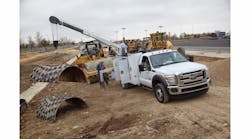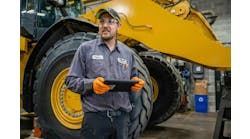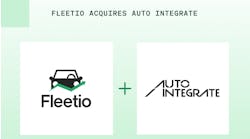Designing a vocational (work) truck is a complex process. A great many considerations need to be addressed to ensure that the vehicle provides the most efficient performance with the lowest operational costs and the least amount of maintenance for its application.
Not to be overlooked in the spec’ing process, say officials with truck OEMS and body and equipment manufacturers and suppliers, is the safety and productivity of the vehicle driver and/or the equipment operator. It is paramount to incorporate designs that are easy on the driver/operator and minimize exposure to safety-related incidents because injuries due to accidents can increase both insurance and workers’ compensation rates, plus impact vehicle and driver/operator productivity.
Too frequently, they note, fleets make the mistake of cutting corners on the fundamentals to save acquisition expenses. It is much more prudent to factor in known costs than to gamble with the unknown expenses and risks that may come from vehicle and equipment shortcuts.
CHASSIS
Safety and uptime comes starts with making certain the truck chassis and body is right for the vehicle’s operational needs, the officials says. That means, among other things, understanding the application requirements and operating environment.
Additionally, it is important to make sure the chassis and its components are capable of handling the loads placed on the completed vehicle. Consideration needs to be given to gross vehicle weight rating (GVWR), gross combined weight rating (GCWR) and the ratings of individual load-carrying components. Much of which has been covered in previous issues of Fleet Maintenance, and this information can be also be found online at VehicleServicePros.com.
DRIVER ERGONOMICS
The driver, obviously, has a critical role in safety. Therefore, do not skimp on driver comfort and amenities. Consider such specs and items as:
- Comfortable, quiet, smoothing-riding cab.
- Tilt and telescoping steering columns.
- Upgraded seats.
- Power windows.
- Heated remote-control mirrors.
- Functional layout of the instrument panel and switches.
VISIBILITY
Good visibility is paramount. Research shows that 90 percent of all driving decisions depend on vision alone. Hence, windshields, windows, mirrors and lights are very important. While the visibility on most of today’s truck models is good, there are still things to be considered.
For example, the larger the cab, the farther apart the windows, which reduces the driver’s field of vision. Cut-down window sills and “peep” windows in the door allow a driver to see more of what is going on alongside his truck.
The height of the truck cab and the hood design affect a driver’s field of vision as well. The bigger the windshield and the greater the slope and shortness of the hood, the better the driver’s forward and right-front view.
Motorized mirrors are easier to adjust than manual mirrors. Plus, they can be moved sideways and up and down. Some models have a convex spot mirror included in the housing and they, too, are often motorized.
Placing convex spot mirrors on front fenders can help eliminate the blind spot alongside the hood and help show what’s beside the rest of the truck.
Mirrors are available with specially coated glass that darkens to cut glare, similar to the way transition eyeglass lenses darken automatically when exposed to sunlight. Mirrors also are available with heating elements to help maintain a clear view by resisting snow, ice, fogging, etc.
There are mirrors that can be mounted on the rear of vehicles to further help reduce blind spots by increasing the driver’s ability to view the area directly behind the vehicle.
Additionally, there are supplemental devices to improve the driver’s rearward vision. These include such things as presence-sensing devices that use sensors to detect objects behind the vehicle and signal a warning to the driver, and rear-mounted direct-viewing systems that employ an onboard camera and monitor to give the driver an actual picture of the area to the rear of the vehicle.
Back-up alarms, also referred to as vehicle motion alarms, are devices intended to warn people nearby the vehicle that it is moving.
LIGHTING
When it comes to lighting, being seen is as important as being able to see. Advances in technology have brought about improvements in lighting applications for trucks. Lights are available with higher power and brightness for enhanced interior illumination, better exterior illumination to make trucks more visible to others vehicles and enhanced forward visibility at night, which reduces driver fatigue.
Light-emitting diode (LED) marker and stop/tail/turn lights provide instantaneous and brighter illumination than incandescent lights. Because LEDs are more efficient, they use less power and last longer.
Contributing to a longer life is their construction. Because they don’t have a filament like incandescent bulbs, LEDs don’t burn out. Plus, they are much more resistant to damage from shock and vibration and are virtually impervious to extreme temperatures.
High Intensity Discharge (HID) lighting produces light using an electrical charge to ignite xenon gas in a small sealed bulb, whereas incandescent and halogen bulbs use filaments. This produces a considerably brighter light while consuming less power with greater durability.
A well-lit work environment is important to staying safe as well. Lighting should provide complete visibility to the work area, storage compartments and within an enclosed body area.
SAFETY TECHNOLOGIES
There are a variety of vehicle safety and driver assist technologies. These can provide a real benefit because research indicates that some 90 percent of motor vehicle crashes are caused, at least in part, by human error.
Among the technologies:
- Collision warning and collision mitigation – These technologies assist drivers in maintaining a safe following distance and detect a high-risk of collision with the vehicle in front. Some systems can help avoid and reduce the impact of rear-end collisions by activating the brakes in emergency situations as needed.
- Adaptive cruise control – An extension of the conventional cruise control system, this technology helps a driver maintain a pre-set distance from the vehicle in front by automatically adjusting the speed of his vehicle.
- Blind spot monitoring – These systems monitor the blind spots around a vehicle and alert the driver to potential hazards in those areas.
- Lane departure warning – These technologies warn a driver of the unintended drift of his vehicle out of the travel lane to help him maintain proper lane position.
The purpose of these types of early warning systems is to increase a driver's knowledge of the area surrounding the vehicle and help them react more quickly to unexpected objects and evade accidents through avoidance maneuvers. It has been reported that 90 percent of truck accidents on the road today could be avoided if the driver had just one second more to react.
Some fleets are spec’ing trucks with air disc brakes because of some advantages they have compared to conventional drum brake. Air disc brakes provide better stopping performance; require less maintenance; are fade-resistant, preventing degradation of stopping power to maintain high braking performance, even in demanding conditions; and require less service time to change brake pads.
ENTRY AND EGRESS
There are more opportunities to reduce potential driver/operator injuries during the truck spec’ing process. These center around the optimal placement of steps and grad handles for easy entry and egress to the cab and body, along with consideration of easy access to truck-mounted equipment, connections and adjustments.
It bears noting that more than half of all driver/operator injuries are due to slips and falls from getting on and off trucks and trailers. The reason being: they take this seemingly simple maneuver for granted. Falls, especially from exiting the cab, are a main source of worker’s compensation claims.
Consequently, the design, size, surface, sturdiness and placement of vehicle steps and grab handles are very important. They should be designed to be convenient and safe at the same time.
A best practice is to provide adequate grad handles to allow the driver/operator to maintain a three-point contact (two hands and one foot or two feet and one hand) while climbing up or down. Also, try to avoid excessively high step-up heights.
Steps that feature a serrated surface that can grab shoe soles tightly and provide solid slip resistance in all directions will help minimize slips. Large, diamond shaped openings keep hazards, such as snow, ice and mud, off the surface. A rear-step bumper and grab handles can facilitate the getting in and out of service, utility, mechanic, etc., type bodies.
LIFTGATES
Depending on the application, a properly spec’d liftgate enables drivers/operators to load and unload heavy cargo/equipment from their trucks more efficiently, and in a way that reduces operator fatigue and injury risk, shortens delivery times, and improves productivity per stop.
When spec’ing a liftgate, keep the weight of the platform in mind, especially those types of liftgates that need to be manually opened, closed and secured. There are options, such as torsion spring assists, that require less effort to open and close a liftgate.
For those trucks that will have moveable components – like cranes, outriggers, winches, etc., – it is wise to take into consideration potential pinch and crush points. Guards should be installed, as needed, and these areas should be “called” out with safety decals or bright paint.
BEST PRACTICE
It is always best to work with truck dealers and body and equipment manufacturers and suppliers when designing a vocational truck.
Getting the appropriate specs will ensure that the completed vehicle is optimized for its job requirements. That will result in less downtime for maintenance and repair, increased reliability and productivity, reduced operating expenses, extended vehicle life and improved safety.
While attempting to cut as much cost out of a new truck purchase will always be an objective, realize that when it comes to safety, it ought to be considered an investment, not an expense.




